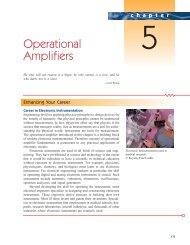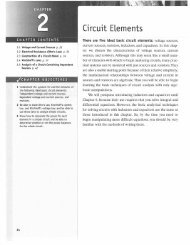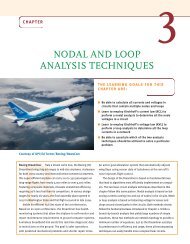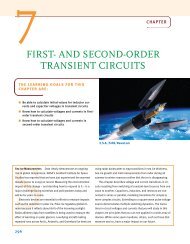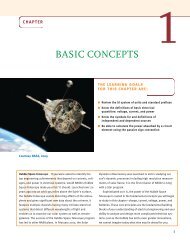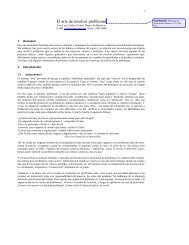Fundamentals of Electric Circuits
Fundamentals of Electric Circuits
Fundamentals of Electric Circuits
You also want an ePaper? Increase the reach of your titles
YUMPU automatically turns print PDFs into web optimized ePapers that Google loves.
3.3 Nodal Analysis with Voltage Sources 89<br />
10 V<br />
4 Ω<br />
Supernode<br />
i 4<br />
i 5 V<br />
2 Ω 1<br />
v<br />
v 2 1 v 3<br />
i 2 i 3<br />
+ −<br />
+ −<br />
8 Ω 6 Ω<br />
Figure 3.7<br />
A circuit with a supernode.<br />
form a generalized node or supernode; we apply both KCL and KVL<br />
to determine the node voltages.<br />
A supernode may be regarded as a<br />
closed surface enclosing the voltage<br />
source and its two nodes.<br />
A supernode is formed by enclosing a (dependent or independent)<br />
voltage source connected between two nonreference nodes and any<br />
elements connected in parallel with it.<br />
In Fig. 3.7, nodes 2 and 3 form a supernode. (We could have more<br />
than two nodes forming a single supernode. For example, see the circuit<br />
in Fig. 3.14.) We analyze a circuit with supernodes using the<br />
same three steps mentioned in the previous section except that the<br />
supernodes are treated differently. Why Because an essential component<br />
<strong>of</strong> nodal analysis is applying KCL, which requires knowing<br />
the current through each element. There is no way <strong>of</strong> knowing the<br />
current through a voltage source in advance. However, KCL must<br />
be satisfied at a supernode like any other node. Hence, at the supernode<br />
in Fig. 3.7,<br />
or<br />
v 1 v 2<br />
2<br />
i 1 i 4 i 2 i 3<br />
v 1 v 3<br />
4<br />
v 2 0<br />
8<br />
v 3 0<br />
6<br />
(3.11a)<br />
(3.11b)<br />
To apply Kirchh<strong>of</strong>f’s voltage law to the supernode in Fig. 3.7, we<br />
redraw the circuit as shown in Fig. 3.8. Going around the loop in the<br />
clockwise direction gives<br />
v 2 5 v 3 0 1 v 2 v 3 5<br />
From Eqs. (3.10), (3.11b), and (3.12), we obtain the node voltages.<br />
Note the following properties <strong>of</strong> a supernode:<br />
(3.12)<br />
1. The voltage source inside the supernode provides a constraint<br />
equation needed to solve for the node voltages.<br />
2. A supernode has no voltage <strong>of</strong> its own.<br />
3. A supernode requires the application <strong>of</strong> both KCL and KVL.<br />
5 V<br />
+ −<br />
+ +<br />
v 2 v 3<br />
Figure 3.8<br />
Applying KVL to a supernode.<br />
−<br />
−




